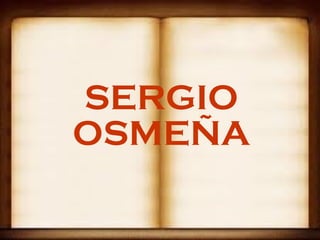
SergioOsmena
- 2. BASIC FACTS: Born: 9-Sep-1878 Birthplace: Cebu City, Philippines Died: 19-Oct-1961 Location of death: Manila, Philippines Cause of death: unspecified Remains: Buried, North Cemetery, Manila, Philippines Gender: Male Race or Ethnicity: Multiracial Sexual orientation: Straight
- 3. Occupation: Head of State Nationality: Philippines Executive summary: 4th President of the Philippines Co-Founder of the Nacionalista Party. Editor of El Nuevo Día newspaper, from 1903. Died at Veteran's Memorial Hospital in Quezon City, Manila. Mother: Juana Osmeña y Suico Son: Sergio Osmeña Jr. (Philippine Senator) University: University of San Carlos (1892) University: San Juan de Letran College, Manila
- 7. Sergio Osmeña y Suico (9 September 1878 – 19 October 1961) was a politician of Chinese Filipino who served as the 4th President of the Philippines from 1944 to 1946.
- 8. He was Vice President under Manuel L. Quezon, and rose to the presidency upon Quezon's death in 1944, being the oldest Philippine president to hold office at age 65. A founder of Nacionalista Party, he was the first Visayan to become President of the Philippines.
- 9. Prior to his succession to the Presidency in 1944, Osmeña served as Governor of Cebu from 1901–1907, Member and Speaker of the Philippine House of Representatives from 1907– 1922, and Senator from the 10th Senatorial District for thirteen years, in which capacity he served as Senate President pro tempore. In 1935, he was nominated to be the running-mate of Senate President Manuel L. Quezon for the presidential election that year. The tandem was overwhelmingly re-elected in 1941.
- 10. Osmeña is the patriarch of the prominent Osmeña family, which includes his son (former Senator Sergio Osmeña, Jr.) and his grandsons (senators Sergio Osmeña III and John Henry Osmeña), ex-governor Lito Osmeña and Cebu City mayor Tomas Osmeña.
- 11. Sergio Osmeña was born in Cebu to Juana Osmeña y Suico, who was reportedly only 14 years of age when she gave birth to him. Owing to the circumstances of his birth, the identity of his father had been a closely guarded family secret. Though an illegitimate child – Juana never married his father – he didn't allow this aspect to affect his standing in society. The Osmeña family, a rich and prominent clan of Chinese Filipino heritage
- 12. He took his elementary education in the Colegio de San Carlos and graduated in 1892. Osmeña continued his education in Manila, studying in San Juan de Letran College where he first metManuel L. Quezon, a classmate of his, as well as Juan Sumulong and Emilio Jacinto. He took up law at the University of Santo Tomas and was second place in the bar examination in 1903.
- 13. He served on the war staff of General Emilio Aguinaldo as a courier and journalist. In 1900, he founded the Cebu newspaper, El Nuevo Día which lasted for three years. In 1904, the American colonial administration appointed him governor of Cebu. Two years later he was elected governor of Cebu
- 15. House of Representatives While governor, he ran for election to the first Philippine Assembly of 1907 and was elected Speaker of that body. Osmeña was 29 years old and already the highest-ranking Filipino official. He and another provincial politician, Manuel L. Quezon of Tayabas, set up the Nacionalista Party as a foil to the Partido Federalista of Manila-based politicians. The two would engage in a rivalry for political dominance ever since.
- 17. Together with Manuel Roxas, Pres. Sergio Osmeña went on a mission to the US to ask for the Philippines' independence. The mission was called OSROX, coined from combining the first letters of their family names. The mission was successful. The Philippines was granted its independence.
- 18. PRESIDENCY Osmeña became president of the Commonwealth on Quezon's death in 1944. He returned to the Philippines the same year with General Douglas MacArthur and the liberation forces. After the war, Osmeña restored the Commonwealth government and the various executive departments. He continued the fight for Philippine independence. For the presidential election of 1946, Osmeña refused to campaign, saying that the Filipino people knew of his record of 40 years of honest and faithful service. He lost to Manuel Roxas, who won 54 percent of the vote and became president of the independent Republic of the Philippines.
- 20. WHO IS THE MOTHER OF SERGIO OSMENA?
- 21. WHAT DO THEY CALL TO THEIR MISSION US FOR PHIL. INDEPENDENCE.
- 22. THANK YOU
